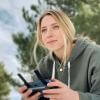Hi everyone,
Tomorrow, June 8, is our fourth and final WILDLABS Virtual Meetup in this Tracking Progress series - we are thrilled to have such an awesome panel of experts joining us to talk about the future of movement ecology. If you haven't registered to join the event yet, you can do that here.
After covering core elements of movement ecology in the first three events - data collection, data analysis, and data sharing and archiving, we're bringing together some of the world's leading experts in the field to explore what the future holds. We want to find out what tools are on the horizon that could shift the trajectory of the field, what new scientific questions they might empower us to ask, and where we need to invest now to harness the potential of these possibilities.
Ahead of the meetup, we wanted to share some of the questions coming in through registration to get the community's thoughts and input. So far, questions are falling into three main categories:
- How the field will/should evolve
- What will the field look like in 10 years? (Finland)
- Movement ecology tomorrow: what is the next step? (Spain)
- What role should open or decentralized science play in the future of tracking? (USA)
- It has been argued that breakthroughs in movement ecology will be driven by big data analyses. But most bio-logging datasets are not open access and there’s a lack of data standardization. How will the community ensure access to data for all and broad participation in new discoveries? (USA)
- What role do you see machine/deep learning playing for movement ecology? Particularly for simulation and prediction. (Australia)
- Future technology developments and possibilities
- What future technologies will help make species protection more effective and efficient in your view? What are some of the near and long-term risks of leveraging these technologies in the field? (USA)
- What is the predicted rate of decline in the per-unit cost of high precision GNSS tracking tags? (Australia)
- What is the future for small terrestrial animal tracking at smaller scales (<1km), but with high precision in dense habitats (forests, meadows, etc.) (Lithuania)
- How can we get high-resolution and large-scale data on animal movement, from individuals to populations, in the wild, in a non-invasive way? (USA)
- Advice about current tools and getting involved
- Which established or emerging types of data management/manipulation should young movement ecologists definitely invest time into learning (e.g., mixed models, HHMs, network analyses, database building, etc.)? (Netherlands)
- What do customers want in future products? New features or priorities: long-lasting or high-frequency data, low-cost or very durable? (Industry perspective - Canada)
- How to improve big data transmission? (United Arab Emirates)
- What are the new tags available to track with high precision locations and mortality alerts? which type of communications networks and additional sensors are available? (Morocco)
These are just a handful of the many interesting questions coming in leading up to the event. What do you all think? Are there other topics we should be considering and asking our experts about? Let us know here in the comments and join the event to ask your own questions.
We hope to see you there!
Talia
9 June 2022 7:11pm
I've been thinking a bit about how to leverage the fact that pretty much all of us are going to be carrying a smartphone with us in the field, and that these smartphones have a network connection, a camera, and a gps receiver. I've thought it would be cool to develop an app that could, simply by taking a picture of a sensor or tag being deployed, use OCR to get its serial number or other identifier, then use the phone's date/time and GPS info to log an entry into a database automatically, whether that's for internal use (i.e. a lab tracking inventory) or for more public use to track all the stuff that's being deployed all over the world. It seems like this wouldn't be a particularly big challenge on the technical end but i'm not a mobile developer.









David Savage
Purdue University